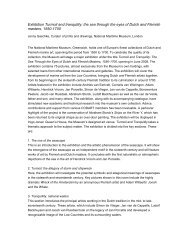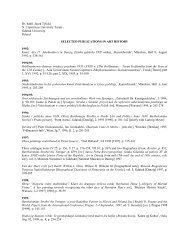Courant 8 - CODART
Courant 8 - CODART
Courant 8 - CODART
You also want an ePaper? Increase the reach of your titles
YUMPU automatically turns print PDFs into web optimized ePapers that Google loves.
codart <strong>Courant</strong> 8/June 2004 2<br />
A word from the<br />
director<br />
On 18 April lotPolish Airline flight lo268<br />
from Schiphol to Warsaw had about an hour<br />
delay in departure. As a result, the codart<br />
zevenstudy trip participants traveling with<br />
the main party arrived late in Warsaw, with a<br />
mild case of nerves about making their quick<br />
connection to Gdan´ sk, where the visit to<br />
Poland began the following morning. The<br />
transit was not as smooth as it might have<br />
been, on account of the far more stringent<br />
security on the inland Warsaw-Gdan´ sk route<br />
than on the international leg of the trip from<br />
Amsterdam to Warsaw. But the plane did not<br />
leave without us, and we reached the Novotel<br />
in Gdan´ sk not long after midnight.<br />
In my bag was an amazingly detailed letter<br />
from the Arts Council of the Netherlands, the<br />
Raad voor Cultuur, mapping out the scenario<br />
for the announcement of its recommendations<br />
to the State Secretary of Culture for the fouryear<br />
funding period 2005-08. The complete text<br />
was to appear on Internet on the Monday<br />
morning, 19 April. The evening before, the 833<br />
individual applicants were to receive an e-mail<br />
from the Council with the text of the<br />
recommendation concerning their own<br />
institution. The continuation of codartin<br />
its present form depended in large measure on<br />
what was in that recommendation.<br />
Getting onto the Internet with your<br />
notebook pc from a Polish hotel room, I have<br />
Photo Thea Vignau-Wilberg<br />
learned in the course of time, is a hit-or-miss<br />
affair. Around 1:30 a.m., after ten or so<br />
unsuccessful attempts to reach call-in<br />
numbers in Poland, Germany and the<br />
Netherlands, I got a hit on a repeat call to<br />
Germany. With my wife Loekie and the<br />
codartassociates Wietske Donkersloot and<br />
Navany Almazan looking over my shoulder, I<br />
read the e-mail and the report.<br />
‘codartmakes an important<br />
contribution to the job of tracking down and<br />
profiling Dutch and Flemish art throughout<br />
the world. The Council concludes that in the<br />
past years codarthas worked in a purposeful<br />
fashion towards the accomplishment of its<br />
aims. Partly with the use of new technologies,<br />
the worldwide network of curators of Dutch<br />
and Flemish art has been charted and made<br />
accessible to the professional field… codart<br />
has put together a well-functioning network<br />
that, among its other functions, furthers the<br />
development of expertise in the area of Dutch<br />
and Flemish art…. The judgment of the<br />
Council concerning codart’s request for<br />
subsidy is positive.’ (For the complete Dutch<br />
text, see http://www.cultuur.nl/cultuurnota.<br />
html.)<br />
Although we had asked for a slightly higher<br />
amount per year than we had been granted for<br />
2001-04, we were relieved and very pleased that<br />
the Council advised the State Secretary to<br />
continue funding us at the old level, 164,000<br />
euros a year. Even though there is a theoretical<br />
possibility that the government will decide<br />
not to follow the recommendation, I am<br />
confident that it will. We clinked our whiskey<br />
glasses, drank to our success and went happily<br />
to sleep.<br />
Those nerves about making connections in<br />
Poland did not end at Warsaw Airport. Polish<br />
society and its physical arrangements are not<br />
exactly a well-oiled machine. In fact, the study<br />
trip presented us at many turns with<br />
unexpected surprises, some of which could<br />
have detracted from the value of the trip. In the<br />
event, none did. All the institutions on our<br />
itinerary were open to us, their staff as helpful<br />
and friendly as we could wish. The buses and<br />
trains were on time, the restaurants were ready<br />
with the meals we ordered. In part because of<br />
our worries that things might go wrong, we<br />
were all the more delighted at how<br />
resoundingly right they went. The promise<br />
held out by our Polish colleagues was – with<br />
one major exception, the postponement of the<br />
exhibition of Dutch and Flemish drawings in<br />
Warsaw (see p. 23) – more than fulfilled.<br />
codart zevenbrought an important<br />
turning point in my own understanding of the<br />
central phenomenon on which codartis<br />
based, the dispersal of Dutch and Flemish art<br />
through the world. Until now, we may have<br />
assumed too easily that the presence abroad of<br />
Netherlandish art implied a positive reception<br />
at the moment of dispersal of the culture of the<br />
Low Countries. In his talk at the congress in<br />
Utrecht on 8 March, Antoni Ziemba, head of<br />
the department of Old Master paintings at the<br />
National Museum in Warsaw, introduced an<br />
important nuance into this way of thinking.<br />
He pointed out that even as Pomeranian cities<br />
like Gdan´ sk were being rebuilt and decorated<br />
in a style we consider Netherlandish, by<br />
architects, artists and engineers from the<br />
Netherlands, local society did not see the<br />
transformation as a specifically Netherlandish<br />
contribution to their culture. The new style<br />
was regarded as a renovation common to all<br />
northern European societies. When it came to<br />
a conscious choice for foreign examples, as in<br />
giving form to the government, Poland turned<br />
decisively to Italy.<br />
This insight brings with it the challenge to<br />
examine more closely the role of Dutch and<br />
Flemish art abroad – and for that matter in the<br />
Low Countries themselves – at each period<br />
since they were made. It gives reason to expand<br />
the intellectual and perhaps even the formal<br />
terms under which codartoperates. Most<br />
importantly, it underscores a principle that we<br />
have embraced from the start: that Dutch and<br />
Flemish art do not form a closed system, but<br />
operate within a larger European and global<br />
culture. That was true in the 16th and 17th<br />
centuries, and it is true today. It is truer than<br />
ever since 1 May 2004, when the Netherlands<br />
and Belgium became equal members, with<br />
Poland and 22 other countries, of a great<br />
European polity. I have always believed that<br />
we belong together, and although not<br />
everyone agrees, it is a wonderful thing that<br />
European unity is getting a chance to prove<br />
itself. If I may be excused for a touch of<br />
arrogance – I wish the European Union as<br />
much good will from its members as codart<br />
enjoys.<br />
Gary Schwartz



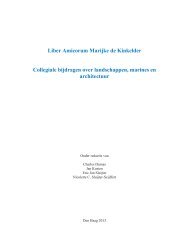
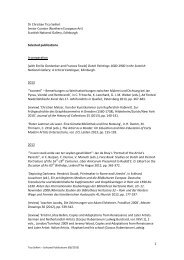

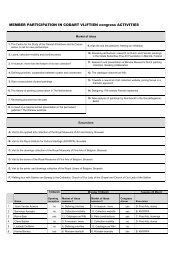

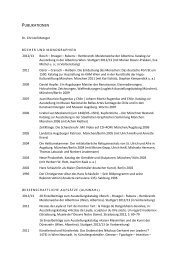

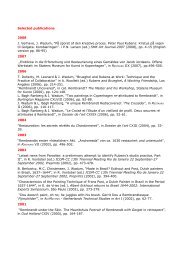
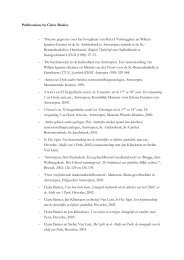
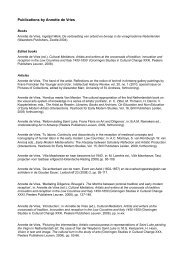
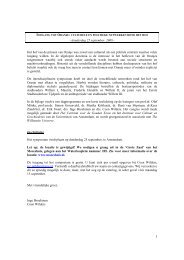
![curriculum [wim] - CODART](https://img.yumpu.com/19451661/1/184x260/curriculum-wim-codart.jpg?quality=85)
![curriculum [wim] - CODART](https://img.yumpu.com/19451660/1/184x260/curriculum-wim-codart.jpg?quality=85)
